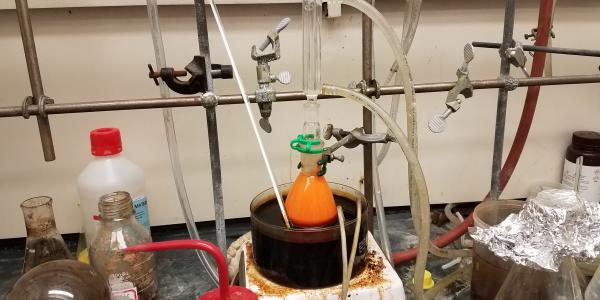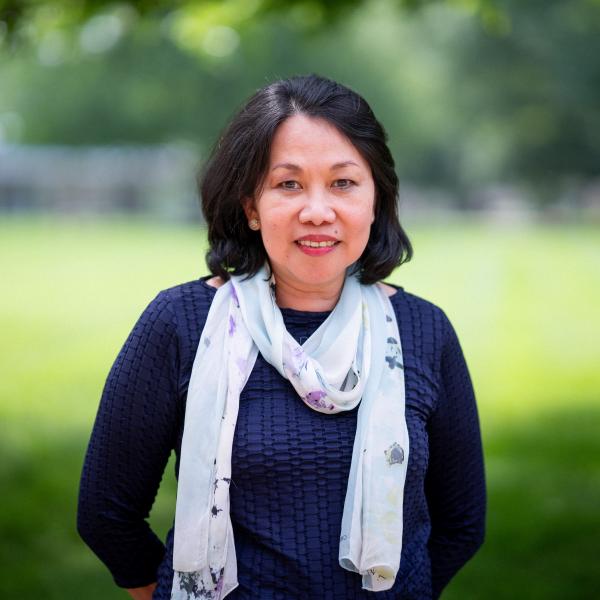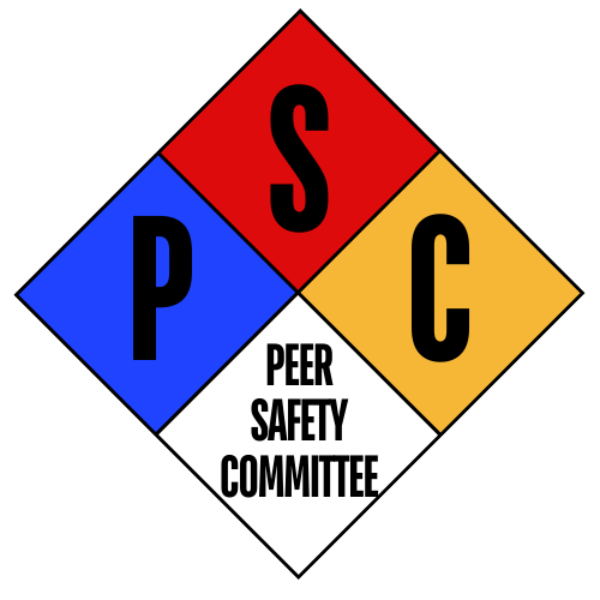Undergraduate chemistry major Khalid Mahmood offers an inside look at what it's like to work in a science lab.
A quick glance at Khalid Mahmood’s lab station shows a chemist hard at work: an assortment of solvents, acids, salts, and more lie within an arm’s reach. At the center, suspended above a pot of oil used for heating, is a flask filled with a vivid orange mixture. Mahmood lifts the flask and pipettes a sample into a small beaker for testing. This Tuesday afternoon, his goal is to analyze this mysterious substance to determine its identity.
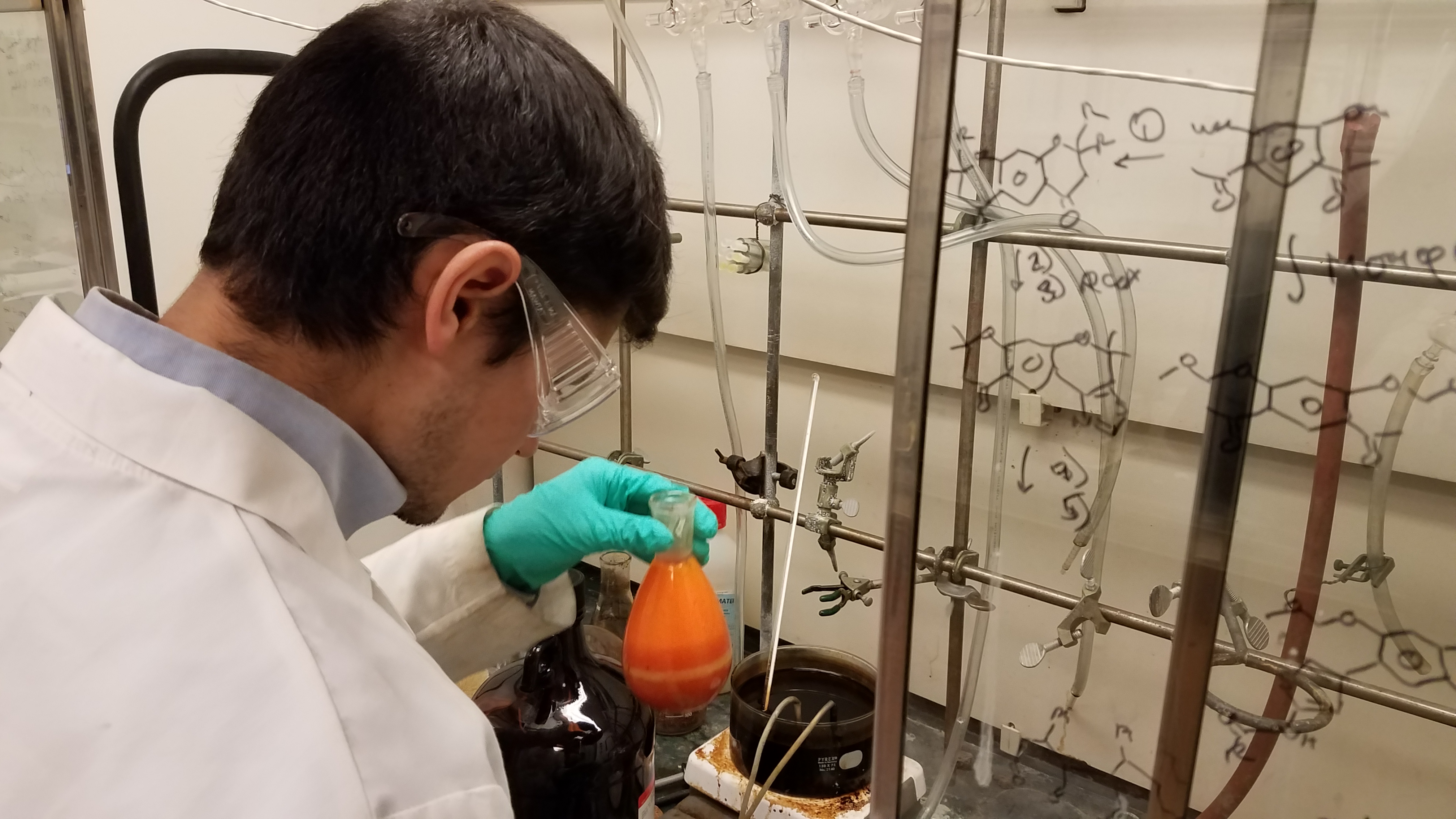
“This is the crude reaction mixture,” he explains. “We started the reaction last week, and now we’re going to see if it has the products that we want.” He knows what materials he started with, and he knows what product he is looking for, but he has no idea if the reaction has occurred successfully.
Mahmood, a senior chemistry major, is conducting research in associate professor Vladimir Birman’s lab. Along with three graduate students, Mahmood is working on developing “molecular muscles” – chain-like molecules that can expand or contract reversibly under certain conditions. If such molecules could be created on a large scale, they would provide a new way to store and transfer energy.
For his part of the project, Mahmood is attempting to synthesize a spacer molecule to connect the expanding and contracting segments. This is a complex, multi-reaction process he started devising last summer when he joined the lab. The reaction he is testing today would, if successful, mark an important step closer to the final synthesis.
The first test Mahmood plans to run is nuclear magnetic resonance (NMR), which uses a property of atomic nuclei called spin to create a partial map of the structure of a molecule. However, his sample is not yet ready to be tested because the product of interest is dissolved in acetone. “I need to concentrate it down because NMR basically measures all the protons. If I have extra acetone in there, all I’m going to see is the acetone,” Mahmood explains.
Mahmood starts purifying his sample with a rotary evaporator. This machine lowers the pressure and raises the temperature inside the beaker, causing the liquid acetone to evaporate. After about two minutes, all the acetone has evaporated, leaving the beaker with an orange solid coating the bottom. Mahmood expects this solid to contain the desired product as well as other materials, so he must do more to purify it.
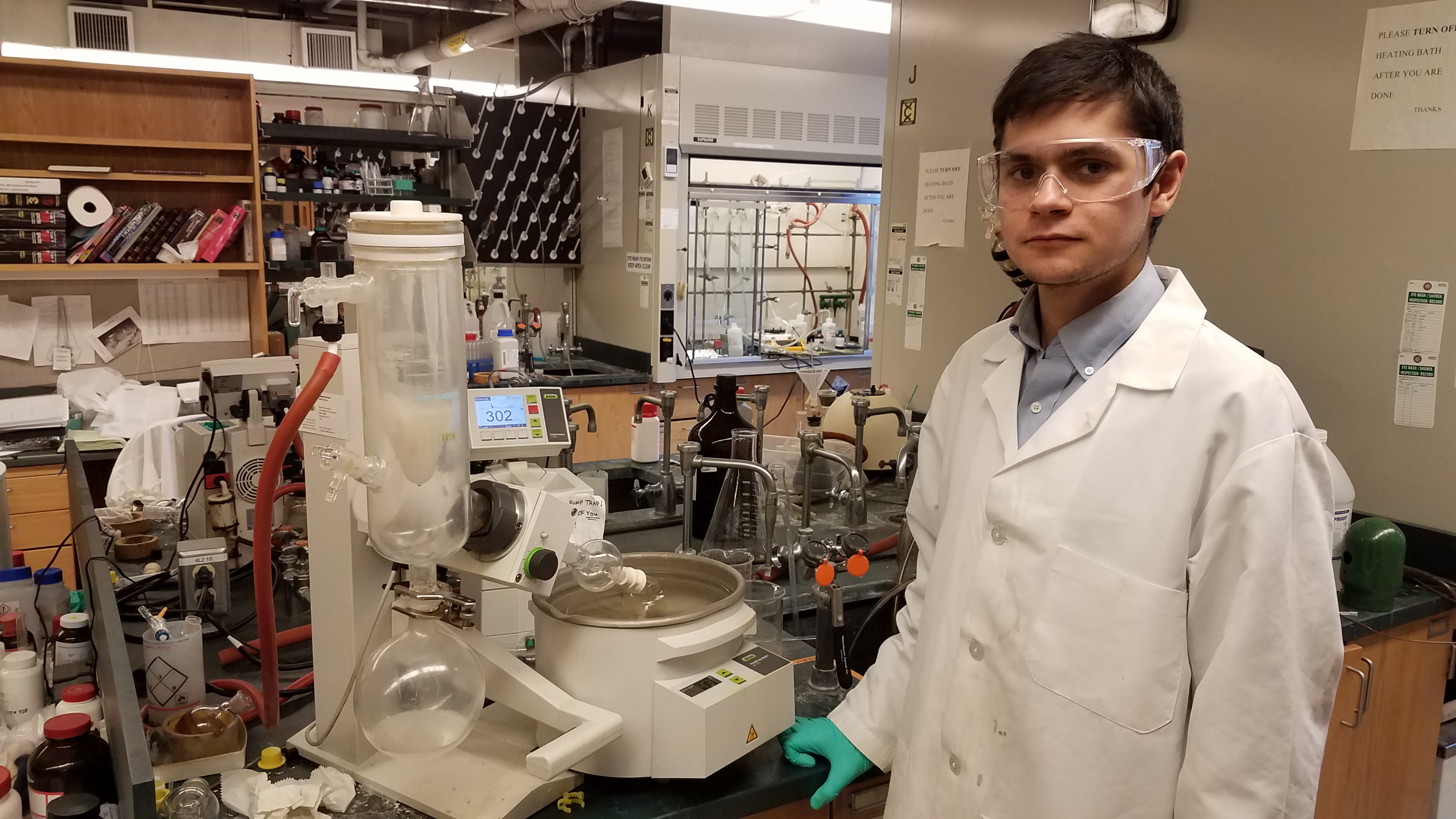
As Mahmood adds small amounts of acid and water, the sample fizzes slightly and turns clear. Then he adds ethyl acetate, pulses the pipette in the beaker to mix it, and lets everything settle. The ethyl acetate, like oil, can’t mix with water, so it separates into an upper layer, drawing with it the reaction product that Mahmood hopes to see on the NMR. He uses a pipette to extract the upper layer and puts it in another beaker.
Now the sample is purified, but for the NMR test Mahmood needs the sample to be dissolved in a liquid called DMSO instead of ethyl acetate. After using the rotary evaporator again to eliminate the ethyl acetate, he adds the DMSO and puts the sample into a thin tube.
With the sample prepared, Mahmood heads to the NMR facility. He inserts the sample in the machine, calibrates the settings, and sits down at a computer to await the results. “In any given molecule, different protons will show up as peaks in the NMR spectrum,” he explains. Comparing these peaks with known reference points allows researchers to determine the structure of the molecule.
Every undergraduate’s path to research is different, but for Mahmood it began with classes taught by an inspiring professor. He got to know Birman by taking three of his classes, including Advanced Organic Laboratory, which marked the transition from well-precedented experiments to independent research. “It’s really cool to make molecules,” he said. “I'm characterizing it, I'm struggling with it, and you know, I'm getting frustrated at it. That’s what research is.” For Mahmood, the struggle makes eventual success that much sweeter.
At Washington University, about 57% of undergraduates engage in research by the time they complete their degree. Dean Joy Kiefer, the director of the Office of Undergraduate Research, emphasized the importance of research to an undergraduate education. “Undergraduate research is one of the hallmark opportunities here at WashU,” she said. “Students who seek to engage in this experience should be curious and interested in the big questions that drive discovery.”
Soon, the computer displays a graph with many peaks, which Mahmood must now analyze. One of the peaks corresponds to the DMSO, and some of the others, he hopes, will correspond to the reaction product. Identifying the region on the graph where the product should appear, Mahmood zooms in to take a closer look. “This is a characterization of the reaction mixture. It indicates something. What that something is, I'm not completely sure.” Many of the peaks sit close together and even overlap, making the analysis more difficult.
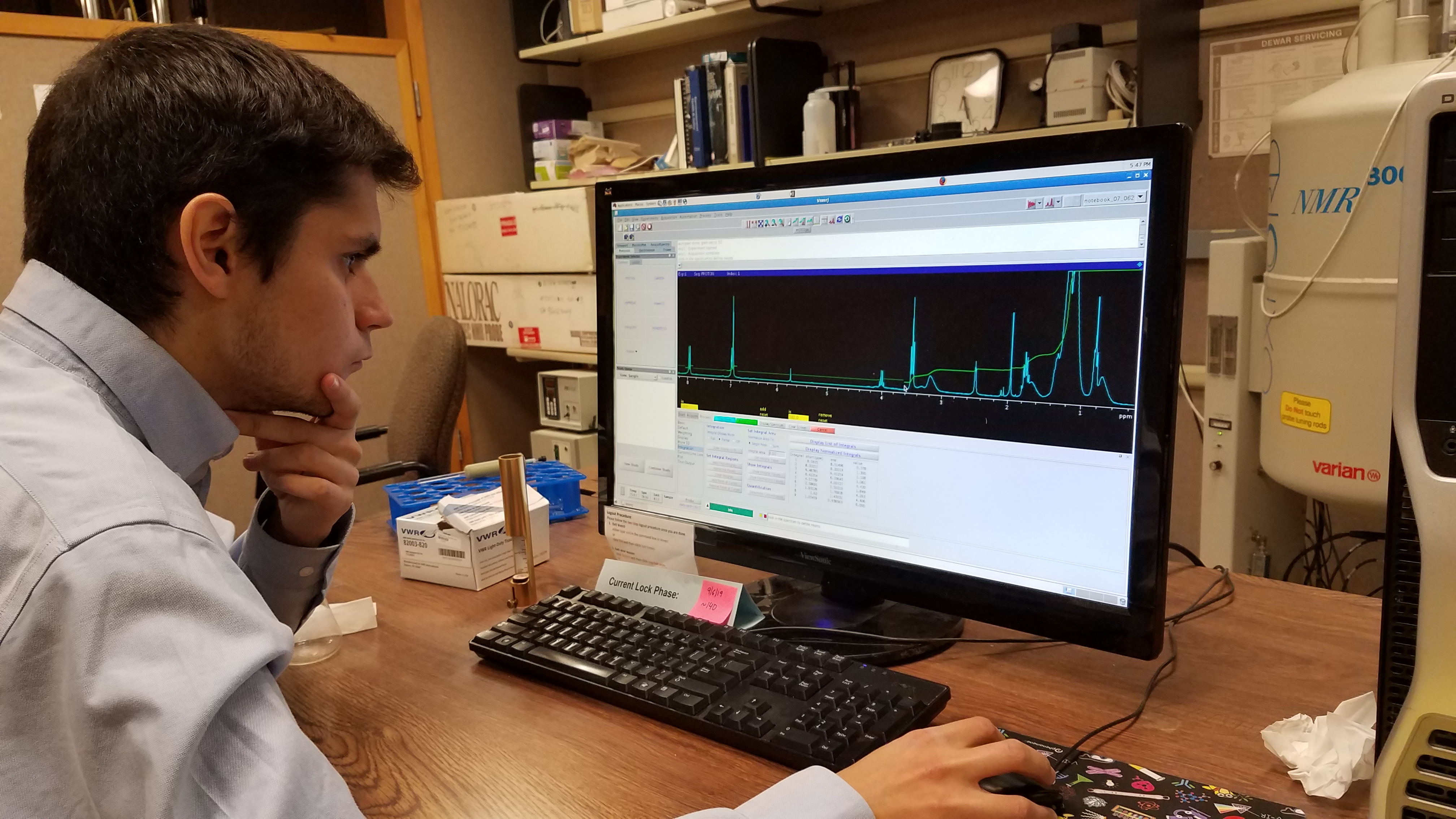
After contemplating the graph for a few more minutes, Mahmood prints a copy and consults with Jingwei Yin, a PhD student in the lab. Yin thinks he can identify some of the peaks, but not enough to reach a definitive conclusion. The two decide that they should run a thin-layer chromatography (TLC) test to gather more data.
Using a short knife, Mahmood cuts a piece of glass coated with silica gel. He puts a drop of the mysterious sample on the glass, and next to it he puts a drop of one of the starting materials he used to create the orange mixture. Dipping the glass vertically in another liquid causes the materials to flow upwards. “I'm spotting the starting materials and the crude reaction mixture side by side and seeing how they move to get a sense of what's what in the reaction mixture,” Mahmood explains.
Last fall, Mahmood applied to PhD programs in chemistry, and he plans to continue in Birman’s lab through the spring semester. He sees his time in the lab as an invaluable experience that has prepared him to take the next step in his education. “While I'm not sure if I want to do academia or not, a PhD in chemistry will open doors,” Mahmood says. “It will allow me to pursue my passion for chemistry and help me make a more informed decision on my career path.”
Dean Kiefer added, “Understanding how we know things, realizing that this is an ever-changing process, helps students see their education from a new and deeper perspective. Washington University has contributed greatly to the creation of a culture of valuing undergraduate research experiences in all academic disciplines nationwide.”
After waiting a minute, Mahmood removes the TLC plate and exposes it to ultraviolet light, which shows him the patterns of movement left by the sample and starting material. He doesn’t like what he sees – the two materials behaved very similarly, suggesting that the desired reaction didn’t happen and that the orange mixture still contains the starting materials.
As a final test, Mahmood adds some of the starting material to his original NMR sample and returns to the NMR room. The result of this second NMR procedure confirms his suspicions: the pattern of peaks is nearly identical to the previous one, meaning that the starting material was already present in the original sample, and thus present in the crude reaction mixture.
Although disappointed by this result, Mahmood remains determined to get the orange mixture to react. Back at the lab bench, he and Yin bounce ideas off each other rapid-fire: Another catalyst? Another solvent? More heat? They quickly settle on all three. Yin adds a powder and a liquid to the reaction mixture, while Mahmood submerges the flask in a hot oil bath. “We’re really pulling out all the stops. We’re throwing everything we’ve got at it,” he says. “Hopefully the molecules can collide more easily, can react more effectively.”
Now they must let the reaction run overnight to see if these changes lead to the creation of the desired product. Packing up his lab gear, Mahmood reflects on the past three hours. “Our first approach didn’t work, as indicated by TLC and NMR, and you know, sometimes you can streamline the synthesis, but in this case we couldn’t.” Setbacks like this are part of the research process, but Mahmood reminds himself that he has made significant progress towards the synthesis of his spacer molecule over the past several months.
“Research is slow, it often is frustrating, sometimes it can be hard to see how day-to-day things can progress, so it’s always good to keep the big picture in mind.”
Khalid Mahmood’s summer research was funded by the Sowden Undergraduate Research Award, supported by the Department of Chemistry and the Office of Undergraduate Research.

